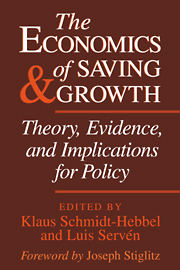6 - Aggregate Saving and Income Distribution
Published online by Cambridge University Press: 18 December 2009
Summary
Introduction
If all individuals were identical in all dimensions related to saving decisions (behavior, endowment, and restrictions they face), then aggregate saving would be trivially related to individual saving – it would just equal the saving of a representative agent multiplied by the population. To determine society's total saving, it would suffice to know the values of the representative agent's income, wealth, and so on. In other words, given the total population, aggregate saving would depend only on the aggregate values of variables such as income and wealth.
If individuals are instead heterogeneous, however, this simple relationship ceases to hold. To be more precise, only under very particular (and restrictive) forms of heterogeneity do aggregate consumption and saving depend exclusively on aggregate quantities. In the more general, and realistic, case in which individual heterogeneity can take arbitrary forms, aggregate consumption and saving patterns inevitably reflect the dissimilar behavior of heterogeneous agents that differ in their preferences, resources, and/or institutional constraints. This, of course, has long been recognized by consumption theory; indeed, consumption and saving are among the few areas in macroeconomics where theoretical developments have occasionally left the safe haven of representative-agent models to venture into the wilderness of agent heterogeneity, collecting along the way valuable analytical and empirical insights – such as those derived, for example, from the life-cycle consumption model.
One particular dimension of heterogeneity that has received increased attention from the macroeconomic viewpoint in recent years is that of income distribution.
- Type
- Chapter
- Information
- The Economics of Saving and GrowthTheory, Evidence, and Implications for Policy, pp. 147 - 188Publisher: Cambridge University PressPrint publication year: 1999
- 1
- Cited by



